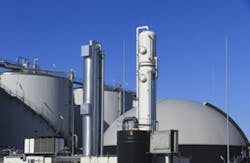There is a growing trend among power, industrial and manufacturing plants towards converting from coal and fuel-oil to cleaner and more efficient energy sources, such as natural gas and biomass sources, according to a report by Industrial Info Resources.
This is particularly notable in the United States where the shale gas boom has led to abundant supplies of cheaper natural gas becoming the new fuel of choice at many of the nation's coal-fired power plants. Industrial Info estimates that such projects are worth more than $800 million in planned total investment value in North America alone–a trend which it expects to keep growing.
According to the U.S. Energy Information Administration, the use of coal to generate electricity was down almost 18 percent for the first seven months of 2012, while natural gas use was up 30 percent. Looking further ahead, the International Energy Agency (IEA) has forecasted that natural gas could replace oil as the largest single fuel in the U.S. energy mix by 2030.
Industrial Info says converting and/or replacing coal-fired plants to burn natural gas is becoming big business and there are number of solid reasons to do so. First off, there's the cost benefit to running a plant on cheaper natural gas. U.S. natural gas prices have fallen by almost 67 percent over five years according to the IEA. With shale gas reserves estimated to remain plentiful in the long term, there's no reason to believe that prices will spike anytime soon. An abundant supply of domestic gas also protects prices from global price swings due to supply issues, competition and political unrest. This gives owners of power plants and industrial plants the stability they require to make the investments needed to switch from fuel-oil or coal.
The other key reason to switch is that by burning natural gas plants become more efficient and emit less CO2 and other noxious gasses, including sulphur oxides, particulate and mercury, to name but a few. As emissions regulations tighten, it makes sense to make the conversion. Industrial Info says this is especially true in Europe where there are strict emissions targets and restrictions in place across all member states.
The Large Combustion Plant Directive (LCPD) is a European Union (E.U.) directive, which requires member states limit emissions from combustion plants with a thermal capacity of 50-megawatts (MW) or greater. It applies to fossil-fuel power stations, as well as to other large thermal plants, such as metal works, chemical plants, and petroleum refineries among others. Any combustion plant built after 1987 must comply with specific emissions limits. From 2007, plants built earlier than that can choose to comply with the emissions limits, or 'opt out'. Those opting out are limited to a maximum of 20,000 hours of further operation, and must close completely by the end of 2015. Many of the U.K.'s older coal power plants such as Kingsnorth, Cockenzie and Ferrybridge are set for closure soon under the LCPD, while others are in the process of converting some of their capacity to burning natural gas or biomass, according to Industrial Info.
To read the full Industrial Info report on this story, click here (registration requied).


